The Ohio Bureau of Criminal Investigation is handling the case and recently released the cruiser cam video that had the faces of the two Middletown officers who conducted the traffic stop blurred to conceal their identities since there have been no charges.
In December 2022, Middletown police received a $49,608 grant from the state to purchase body cameras. Police Chief David Birk requested $124,218.
But Birk told the Journal-News the city rejected the grant because it doesn’t have the money to pay the salary and benefits for one or maybe two redaction specialists, estimated at $65,000 each.
He said the department would need at least one, and possible two redaction specialists, due to the high volume of public records requests. Also, he said, the department would have to store all the body camera videos for at least one year.
“Right now,” he said, “the cost outweighs the benefits.”
Birk, though, was quick to point out he’s a “big advocate” for body cameras because he thinks they “show the officers are doing what’s right. And I think it benefits them.”
The department will continue to apply for grants to offset the cost of employees, he said.
Middletown has about 40 patrol officers out of 73 officers total on the force, including detectives, narcotics and school resource officers.
He said the department is “very fortunate” that its six new police cruisers are equipped with cameras.
WHEN BODY CAMERAS ARE EXEMPT FROM DISCLOSURE
A law took effect in 2019 that gave guidance for using body cameras. It identified 17 instances in which video recorded by body cameras are exempt from disclosure. Among them are:
• Inside a residence unless the incident involves “an adversarial encounter with, or a use of force by, a peace officer”
• Showing children
• A death or body, unless it was caused by a peace officer
• A nude body, unless the person consents
• “Grievous” bodily harm to a peace officer, firefighter, paramedic or other first responder
